 To enhance service speed and avoid tariff delays, we've opened a US warehouse. All US orders ship directly from our US facility.
To enhance service speed and avoid tariff delays, we've opened a US warehouse. All US orders ship directly from our US facility.
| Cat. No. | Product Name | Field of Application | Chemical Structure |
|---|---|---|---|
| DC9257 | NSC59984 Featured |
NSC59984 induces mutant p53 protein degradation via MDM2 and the ubiquitin-proteasome pathway.The EC50 of NSC59984 in most cancer cells is significantly lower than those of normal cells, with EC50 of 8.38 μM for p53-null HCT116 cells.
More description
|

|
| DC10074 | MX69 Featured |
MX69 is the MDM2/XIAP inhibitor, used for cancer treatment.
More description
|

|
| DC10613 | NVP-HDM201(Siremadlin ) Featured |
HDM201 is an orally bioavailable human double minute 2 homolog (HDM2) inhibitor with potential antineoplastic activity.
More description
|

|
| DC72548 | GN25 |
GN25 is a specific p53-Snail binding inhibitor with antitumor effects.
More description
|

|
| DC72547 | C16-Ceramide |
C16-Ceramide is a natural small molecule activating p53 through the direct and selective binding.
More description
|

|
| DC42466 | Amifostine thiol |
Amifostine thiol (WR-1065) is an active metabolite of the cytoprotector Amifostine. Amifostine thiol is a cytoprotective agent with radioprotective abilities. Amifostine thiol activates p53 through a JNK-dependent signaling pathway.
More description
|

|
| DC71976 | BI-0282 |
BI-0282 (Compound 1) is a potent MDM2-p53 interaction inhibitor.
More description
|

|
| DC11837 | RO-5963 Featured |
RO-5963 is an inhibitor of the interaction of both MDM2 and MDMX with p53.
More description
|

|
| DC71293 | NSC90616 |
NSC90616 is a mutant p53 rescue compound.
More description
|

|
| DC9902 | PRIMA-1 Featured |
PRIMA-1 is a mutant p53 reactivator, restores the sensitivity of TP53 mutant-type thyroid cancer cells to the histone methylation inhibitor 3-Deazaneplanocin A.
More description
|
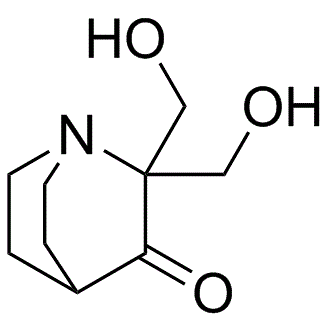
|
| DC8865 | RG-7112 Featured |
RG7112 (RO5045337) is an orally bioavailable and selective p53-MDM2 inhibitor.
More description
|
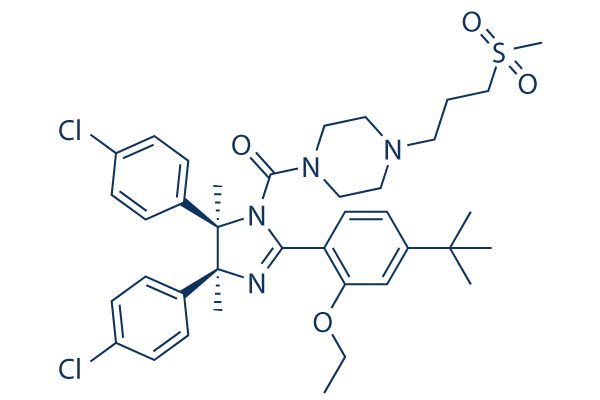
|
| DC8467 | RO8994 Featured |
RO8994 is a potent and selective spiroindolinone MDM2 inhibitor for cancer therapy.
More description
|
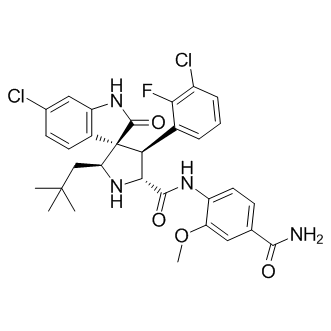
|
| DC10851 | PK11000 Featured |
PK11000 is an alkylating agent, and stabilizes the DNA-binding domain of both WT and mutant p53 by covalent cysteine modification, without compromising DNA binding.
More description
|
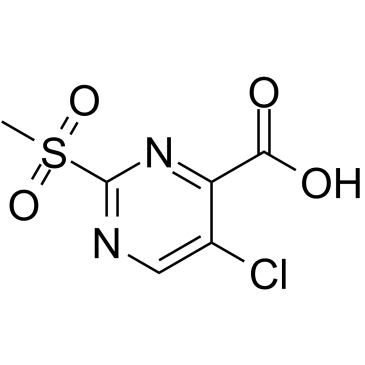
|
| DC70476 | H210 |
H210 is a potent dual Mdm2/MdmX inhibitor with Ki of 9.66/2.89 nM, respectively.
More description
|

|
| DC70186 | ALRN-6924 |
ALRN-6924 (ALRN6924) is a potent dual inhibitor of MDM2/MDMX.ALRN-6924 demonstrated potent anti-proliferative activity in a dose-dependent manner in two ER+ cell lines with WT TP53, MCF-7 and ZR-75-1, with IC50 values of 113 nM and 500 nM respectively.The combination of ALRN-6924 and chemotherapeutic agents synergistically inhibit cell proliferation in vitro, ALRN-6924 combined with paclitaxel reactivates p53 and induces cell cycle arrest and apoptosis in vitro.ALRN-6924 mutually enhances both paclitaxel and eribulin antitumor efficacy and inhibits tumor growth in vivo.
More description
|

|
| DC70131 | DIMP53-1 |
A novel small-molecule dual inhibitor of p53-MDM2/X interactions by potentially binding to p53, without effect on other MDM; causes growth inhibition, mediated by p53 stabilization and upregulation of p53 transcriptional targets involved in cell cycle arrest and apoptosis; shows a p53-dependent antitumor activity in human tumor xenograft mice models; a novel p53 activator.
More description
|

|
| DC70067 | NSC194598 |
NSC194598 is a specific small molecule inhibitor that inhibits p53 sequence-specific DNA binding in vitro (IC50=180 nM) and in vivo.
More description
|

|
| DC50252 | NSC405640 |
NSC405640 is a potent inhibitor of the MDM2-p53 interaction. NSC405640 rescues structural p53 mutations. NSC405640 selectively inhibits the growth of cell lines with wild-type p53.
More description
|

|
| DC50251 | Mutant p53 modulator-1 |
Mutant p53 modulator-1 is a mutant p53 modulator. Mutant p53 modulator-1 reduces the progression of cancers that contain a p53 mutation (extracted from patent WO2021231474A1, compound 231B).
More description
|

|
| DC50250 | PK9327 |
PK9327 is a small-molecule stabilizer targeting cavity-creating p53 cancer mutations.
More description
|

|
| DC49533 | ADH-6 |
ADH-6 is a tripyridylamide compound. ADH-6 abrogates self-assembly of the aggregation-nucleating subdomain of mutant p53 DBD. ADH-6 targets and dissociates mutant p53 aggregates in human cancer cells, which restores p53's transcriptional activity, leading to cell cycle arrest and apoptosis. ADH-6 has the potential for the research of cancer diseases.
More description
|

|
| DC11669 | CB-002 Featured |
CB-002 is a novel small molecule that restores p53 function in mutant p53-expressing colorectal cancer cells without toxicity to normal human fibroblasts; increases expression of endogenous p53 target genes NOXA, DR5, and p21 and cell death; decreases the stability of mutant p53 in RXF393 cancer cells and an exogenously expressed R175H p53 mutant in HCT116 p53-null cells.
More description
|

|
| DC8599 | SP 141 Featured |
SP 141 is a cell-permeable inhibitor of Mdm2 (Ki = 28 nM).
More description
|
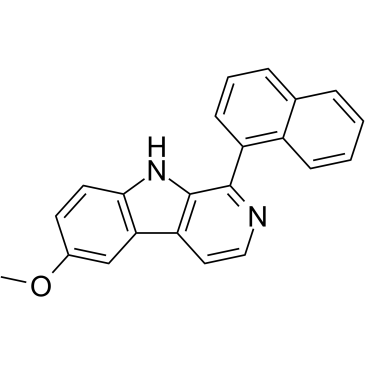
|
| DC48419 | MA242 free base |
MA242 free base is a specific dual inhibitor of MDM2 and NFAT1. MA242 free base directly binds both MDM2 and NFAT1 with high affinity, induces their protein degradation, and inhibits NFAT1-mediated transcription of MDM2. MA242 free base induces apoptosis in pancreatic cancer cell lines regardless of p53 status.
More description
|

|
| DC7175 | JNJ-26854165 (Serdemetan) Featured |
JNJ-26854165 (Serdemetan) acts as a HDM2 ubiquitin ligase antagonist and also induces early apoptosis in p53 wild-type cells, inhibits cellular proliferation followed by delayed apoptosis in the absence of functional p53.
More description
|

|
| DC8414 | MI-77301 (SAR405838) Featured |
MI-77301 (SAR405838) is an orally available MDM2 antagonist with Ki of 0.88 nM. Phase 1.
More description
|

|
| DC47576 | Sanggenol L |
Sanggenol L induces caspase-dependent and caspase-independent apoptosis in melanoma skin cancer cells. Sanggenol L induces of apoptosis via suppression of PI3K/Akt/mTOR signaling and cell cycle arrest via activation of p53 in p
More description
|

|
| DC47288 | Teprasiran |
Teprasiran (QPI-1002) is a small interfering RNA that temporarily inhibits p53-mediated cell death that underlies acute kidney injury (AKI).
More description
|

|
| DC46420 | MDM2-IN-21 |
MDM2-IN-21 is a potent MDM2 inhibitor. MDM2-IN-21 can be used for the research of cancer.
More description
|

|
| DC9506 | SJ-172550 Featured |
SJ-172550 is the first MDMX inhibitor with EC50 of 0.84 uM; binds reversibly to MDMX and effectively kills retinoblastoma cells in which the expression of MDMX is amplified.
More description
|
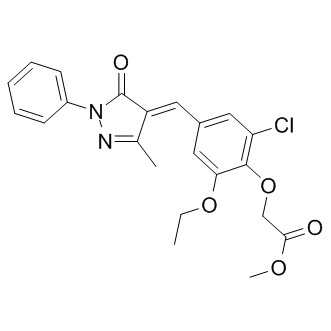
|